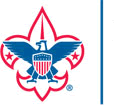 Scout is the first rank a new Scout can earn. The Scout badge has a gold fleur-de-lis on a tan background. The fleur-de-lis symbolizes a compass needle. The needle points the Scout in the right direction, which is onward and upward. The badge is awarded when the Scout demonstrates knowledge of Scouting ideals such as tying square, taught-line hitch and two half-hitch knots, knowing the Scout oath, law, motto, slogan, sign, salute, handshake, pocketknife safety and a few additional Boy Scout organizational topics. Scout is the first rank a new Scout can earn. The Scout badge has a gold fleur-de-lis on a tan background. The fleur-de-lis symbolizes a compass needle. The needle points the Scout in the right direction, which is onward and upward. The badge is awarded when the Scout demonstrates knowledge of Scouting ideals such as tying square, taught-line hitch and two half-hitch knots, knowing the Scout oath, law, motto, slogan, sign, salute, handshake, pocketknife safety and a few additional Boy Scout organizational topics. |
 Tenderfoot is the second rank. The Tenderfoot badge takes the fleur-de-lis of the Scout badge and adds two stars and an eagle with an American shield. The stars symbolize truth and knowledge; the eagle and shield symbolize freedom and readiness to defend it. A Scout can work on the requirements for the Tenderfoot, Second Class, and First Class ranks at the same time, but each rank must be earned in sequence. The badge is awarded when the Scout completes requirements in the areas of Scoutcraft, physical fitness, citizenship, personal growth, leadership and Scout Spirit. Tenderfoot is the second rank. The Tenderfoot badge takes the fleur-de-lis of the Scout badge and adds two stars and an eagle with an American shield. The stars symbolize truth and knowledge; the eagle and shield symbolize freedom and readiness to defend it. A Scout can work on the requirements for the Tenderfoot, Second Class, and First Class ranks at the same time, but each rank must be earned in sequence. The badge is awarded when the Scout completes requirements in the areas of Scoutcraft, physical fitness, citizenship, personal growth, leadership and Scout Spirit. |
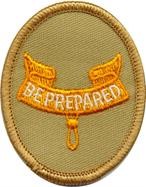 Second Class is the rank above Tenderfoot and below First Class. The Second Class badge features a scroll inscribed with the Scout Motto, with the ends turned up and a knotted rope hanging from the bottom. The knot reminds each Scout to remember the Scout slogan, and the upturned ends of the scroll symbolize cheerfulness in service. A Scout can work on the requirements for Tenderfoot, Second Class, and First Class at the same time, but the ranks must be earned in sequence. The badge is awarded when the Scout completes requirements in the areas of Scoutcraft, nature, navigation, physical fitness, citizenship, leadership and Scout Spirit. Second Class is the rank above Tenderfoot and below First Class. The Second Class badge features a scroll inscribed with the Scout Motto, with the ends turned up and a knotted rope hanging from the bottom. The knot reminds each Scout to remember the Scout slogan, and the upturned ends of the scroll symbolize cheerfulness in service. A Scout can work on the requirements for Tenderfoot, Second Class, and First Class at the same time, but the ranks must be earned in sequence. The badge is awarded when the Scout completes requirements in the areas of Scoutcraft, nature, navigation, physical fitness, citizenship, leadership and Scout Spirit. |
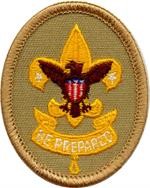 First Class is the fourth rank and is above Second Class and below Star Scout. The First Class badge combines elements of the Tenderfoot and Second Class badges and is the minimum rank required for entry into the Order of the Arrow or for a Scout to be a troop Senior Patrol Leader (SPL). For a brief period in BSA’s history, and prior to the introduction of Eagle Scout, First Class was the highest rank in the BSA; for several more years, it was the highest rank needed to earn Eagle. The First Class badge is awarded when the Scout completes requirements in the areas of Scoutcraft, physical fitness, citizenship, outdoor ethics, emergency preparedness, leadership and Scout Spirit. First Class is the fourth rank and is above Second Class and below Star Scout. The First Class badge combines elements of the Tenderfoot and Second Class badges and is the minimum rank required for entry into the Order of the Arrow or for a Scout to be a troop Senior Patrol Leader (SPL). For a brief period in BSA’s history, and prior to the introduction of Eagle Scout, First Class was the highest rank in the BSA; for several more years, it was the highest rank needed to earn Eagle. The First Class badge is awarded when the Scout completes requirements in the areas of Scoutcraft, physical fitness, citizenship, outdoor ethics, emergency preparedness, leadership and Scout Spirit. |
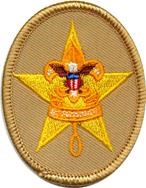 Star is the rank above First Class and below Life Scout. Star has a First Class symbol on a five-pointed yellow star, and initially indicated the five merit badges required to earn the rank. That symbolism was lost when the number of merit badges required for Star was increased to six in 1990. Star is awarded when the Scout serves actively in the troop in a position of responsibility for at least 4 months as a First Class Scout; performs at least six hours of service through one or more service projects and earns six merit badges (four of which must be from the required list for Eagle Scout). Star is the rank above First Class and below Life Scout. Star has a First Class symbol on a five-pointed yellow star, and initially indicated the five merit badges required to earn the rank. That symbolism was lost when the number of merit badges required for Star was increased to six in 1990. Star is awarded when the Scout serves actively in the troop in a position of responsibility for at least 4 months as a First Class Scout; performs at least six hours of service through one or more service projects and earns six merit badges (four of which must be from the required list for Eagle Scout). |
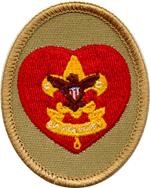 Life is the second highest rank attainable and ranks above Star Scout and below Eagle. Life has a First Class emblem on a red heart, and initially symbolized the first-aid and health-related merit badges that the rank required. Now it signifies that the ideals of Scouting have become a part of the Scout’s life and character. Life is awarded when the Scout actively serves in the troop as a Star Scout in a position of responsibility for six months, and performs six hours of service on one or more service projects, three hours of which in conservation related service. A Scout must also earn an additional five merit badges (three of which are from the required list for Eagle), to make a total of eleven merit badges (including the six previously required for Star). Life is the second highest rank attainable and ranks above Star Scout and below Eagle. Life has a First Class emblem on a red heart, and initially symbolized the first-aid and health-related merit badges that the rank required. Now it signifies that the ideals of Scouting have become a part of the Scout’s life and character. Life is awarded when the Scout actively serves in the troop as a Star Scout in a position of responsibility for six months, and performs six hours of service on one or more service projects, three hours of which in conservation related service. A Scout must also earn an additional five merit badges (three of which are from the required list for Eagle), to make a total of eleven merit badges (including the six previously required for Star). |
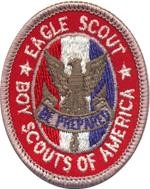 Eagle Scout is the highest rank attainable in the Boy Scout division of the Boy Scouts of America. Since its introduction in 1911, the Eagle Scout rank has been earned by more than 2.25 million young men. Requirements include earning at least 21 merit badges, thirteen of which are Eagle required, and demonstration of Scout Spirit, service and leadership. This includes an extensive service project that the Scout plans, organizes, leads, and manages. An Eagle Scout receives both a medal and a badge to show their accomplishment. And an Eagle Scout entering the military enjoys a 1 pay grade boost. Colleges and universities also favor Eagle Scouts when reviewing college applications. Eagle Scout is the highest rank attainable in the Boy Scout division of the Boy Scouts of America. Since its introduction in 1911, the Eagle Scout rank has been earned by more than 2.25 million young men. Requirements include earning at least 21 merit badges, thirteen of which are Eagle required, and demonstration of Scout Spirit, service and leadership. This includes an extensive service project that the Scout plans, organizes, leads, and manages. An Eagle Scout receives both a medal and a badge to show their accomplishment. And an Eagle Scout entering the military enjoys a 1 pay grade boost. Colleges and universities also favor Eagle Scouts when reviewing college applications. |
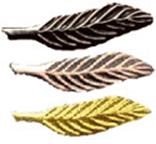 Eagle Palms are the recognition devices presented to Eagle Scouts for their continued service to their troop. Requirements include 3 months, or an additional 3 months, tenure as an Eagle Scout, earning 5 additional merit badges beyond the 21 required for Eagle, showing Scout Spirit and the passing of a Scoutmaster conference and a board of review. For 5 merit badges earned above the required 21, the Eagle Scout receives a Bronze Palm. For 10 merit badges earned and 3 more months served – a Gold Palm. For 15 merit badges earned beyond the required 21 for Eagle and an additional 3 months of tenure, a Silver Palm is earned. The cycle is repeated if more merit badges are earned and enough time is left before an Eagle Scout turns 18. Eagle Palms are the recognition devices presented to Eagle Scouts for their continued service to their troop. Requirements include 3 months, or an additional 3 months, tenure as an Eagle Scout, earning 5 additional merit badges beyond the 21 required for Eagle, showing Scout Spirit and the passing of a Scoutmaster conference and a board of review. For 5 merit badges earned above the required 21, the Eagle Scout receives a Bronze Palm. For 10 merit badges earned and 3 more months served – a Gold Palm. For 15 merit badges earned beyond the required 21 for Eagle and an additional 3 months of tenure, a Silver Palm is earned. The cycle is repeated if more merit badges are earned and enough time is left before an Eagle Scout turns 18. |
 Scout is the first rank a new Scout can earn. The Scout badge has a gold fleur-de-lis on a tan background. The fleur-de-lis symbolizes a compass needle. The needle points the Scout in the right direction, which is onward and upward. The badge is awarded when the Scout demonstrates knowledge of Scouting ideals such as tying square, taught-line hitch and two half-hitch knots, knowing the Scout oath, law, motto, slogan, sign, salute, handshake, pocketknife safety and a few additional Boy Scout organizational topics.
Scout is the first rank a new Scout can earn. The Scout badge has a gold fleur-de-lis on a tan background. The fleur-de-lis symbolizes a compass needle. The needle points the Scout in the right direction, which is onward and upward. The badge is awarded when the Scout demonstrates knowledge of Scouting ideals such as tying square, taught-line hitch and two half-hitch knots, knowing the Scout oath, law, motto, slogan, sign, salute, handshake, pocketknife safety and a few additional Boy Scout organizational topics. Tenderfoot is the second rank. The Tenderfoot badge takes the fleur-de-lis of the Scout badge and adds two stars and an eagle with an American shield. The stars symbolize truth and knowledge; the eagle and shield symbolize freedom and readiness to defend it. A Scout can work on the requirements for the Tenderfoot, Second Class, and First Class ranks at the same time, but each rank must be earned in sequence. The badge is awarded when the Scout completes requirements in the areas of Scoutcraft, physical fitness, citizenship, personal growth, leadership and Scout Spirit.
Tenderfoot is the second rank. The Tenderfoot badge takes the fleur-de-lis of the Scout badge and adds two stars and an eagle with an American shield. The stars symbolize truth and knowledge; the eagle and shield symbolize freedom and readiness to defend it. A Scout can work on the requirements for the Tenderfoot, Second Class, and First Class ranks at the same time, but each rank must be earned in sequence. The badge is awarded when the Scout completes requirements in the areas of Scoutcraft, physical fitness, citizenship, personal growth, leadership and Scout Spirit. Second Class is the rank above Tenderfoot and below First Class. The Second Class badge features a scroll inscribed with the Scout Motto, with the ends turned up and a knotted rope hanging from the bottom. The knot reminds each Scout to remember the Scout slogan, and the upturned ends of the scroll symbolize cheerfulness in service. A Scout can work on the requirements for Tenderfoot, Second Class, and First Class at the same time, but the ranks must be earned in sequence. The badge is awarded when the Scout completes requirements in the areas of Scoutcraft, nature, navigation, physical fitness, citizenship, leadership and Scout Spirit.
Second Class is the rank above Tenderfoot and below First Class. The Second Class badge features a scroll inscribed with the Scout Motto, with the ends turned up and a knotted rope hanging from the bottom. The knot reminds each Scout to remember the Scout slogan, and the upturned ends of the scroll symbolize cheerfulness in service. A Scout can work on the requirements for Tenderfoot, Second Class, and First Class at the same time, but the ranks must be earned in sequence. The badge is awarded when the Scout completes requirements in the areas of Scoutcraft, nature, navigation, physical fitness, citizenship, leadership and Scout Spirit. First Class is the fourth rank and is above Second Class and below Star Scout. The First Class badge combines elements of the Tenderfoot and Second Class badges and is the minimum rank required for entry into the Order of the Arrow or for a Scout to be a troop Senior Patrol Leader (SPL). For a brief period in BSA’s history, and prior to the introduction of Eagle Scout, First Class was the highest rank in the BSA; for several more years, it was the highest rank needed to earn Eagle. The First Class badge is awarded when the Scout completes requirements in the areas of Scoutcraft, physical fitness, citizenship, outdoor ethics, emergency preparedness, leadership and Scout Spirit.
First Class is the fourth rank and is above Second Class and below Star Scout. The First Class badge combines elements of the Tenderfoot and Second Class badges and is the minimum rank required for entry into the Order of the Arrow or for a Scout to be a troop Senior Patrol Leader (SPL). For a brief period in BSA’s history, and prior to the introduction of Eagle Scout, First Class was the highest rank in the BSA; for several more years, it was the highest rank needed to earn Eagle. The First Class badge is awarded when the Scout completes requirements in the areas of Scoutcraft, physical fitness, citizenship, outdoor ethics, emergency preparedness, leadership and Scout Spirit. Star is the rank above First Class and below Life Scout. Star has a First Class symbol on a five-pointed yellow star, and initially indicated the five merit badges required to earn the rank. That symbolism was lost when the number of merit badges required for Star was increased to six in 1990. Star is awarded when the Scout serves actively in the troop in a position of responsibility for at least 4 months as a First Class Scout; performs at least six hours of service through one or more service projects and earns six merit badges (four of which must be from the required list for Eagle Scout).
Star is the rank above First Class and below Life Scout. Star has a First Class symbol on a five-pointed yellow star, and initially indicated the five merit badges required to earn the rank. That symbolism was lost when the number of merit badges required for Star was increased to six in 1990. Star is awarded when the Scout serves actively in the troop in a position of responsibility for at least 4 months as a First Class Scout; performs at least six hours of service through one or more service projects and earns six merit badges (four of which must be from the required list for Eagle Scout). Life is the second highest rank attainable and ranks above Star Scout and below Eagle. Life has a First Class emblem on a red heart, and initially symbolized the first-aid and health-related merit badges that the rank required. Now it signifies that the ideals of Scouting have become a part of the Scout’s life and character. Life is awarded when the Scout actively serves in the troop as a Star Scout in a position of responsibility for six months, and performs six hours of service on one or more service projects, three hours of which in conservation related service. A Scout must also earn an additional five merit badges (three of which are from the required list for Eagle), to make a total of eleven merit badges (including the six previously required for Star).
Life is the second highest rank attainable and ranks above Star Scout and below Eagle. Life has a First Class emblem on a red heart, and initially symbolized the first-aid and health-related merit badges that the rank required. Now it signifies that the ideals of Scouting have become a part of the Scout’s life and character. Life is awarded when the Scout actively serves in the troop as a Star Scout in a position of responsibility for six months, and performs six hours of service on one or more service projects, three hours of which in conservation related service. A Scout must also earn an additional five merit badges (three of which are from the required list for Eagle), to make a total of eleven merit badges (including the six previously required for Star). Eagle Scout is the highest rank attainable in the Boy Scout division of the Boy Scouts of America. Since its introduction in 1911, the Eagle Scout rank has been earned by more than 2.25 million young men. Requirements include earning at least 21 merit badges, thirteen of which are Eagle required, and demonstration of Scout Spirit, service and leadership. This includes an extensive service project that the Scout plans, organizes, leads, and manages. An Eagle Scout receives both a medal and a badge to show their accomplishment. And an Eagle Scout entering the military enjoys a 1 pay grade boost. Colleges and universities also favor Eagle Scouts when reviewing college applications.
Eagle Scout is the highest rank attainable in the Boy Scout division of the Boy Scouts of America. Since its introduction in 1911, the Eagle Scout rank has been earned by more than 2.25 million young men. Requirements include earning at least 21 merit badges, thirteen of which are Eagle required, and demonstration of Scout Spirit, service and leadership. This includes an extensive service project that the Scout plans, organizes, leads, and manages. An Eagle Scout receives both a medal and a badge to show their accomplishment. And an Eagle Scout entering the military enjoys a 1 pay grade boost. Colleges and universities also favor Eagle Scouts when reviewing college applications. Eagle Palms are the recognition devices presented to Eagle Scouts for their continued service to their troop. Requirements include 3 months, or an additional 3 months, tenure as an Eagle Scout, earning 5 additional merit badges beyond the 21 required for Eagle, showing Scout Spirit and the passing of a Scoutmaster conference and a board of review. For 5 merit badges earned above the required 21, the Eagle Scout receives a Bronze Palm. For 10 merit badges earned and 3 more months served – a Gold Palm. For 15 merit badges earned beyond the required 21 for Eagle and an additional 3 months of tenure, a Silver Palm is earned. The cycle is repeated if more merit badges are earned and enough time is left before an Eagle Scout turns 18.
Eagle Palms are the recognition devices presented to Eagle Scouts for their continued service to their troop. Requirements include 3 months, or an additional 3 months, tenure as an Eagle Scout, earning 5 additional merit badges beyond the 21 required for Eagle, showing Scout Spirit and the passing of a Scoutmaster conference and a board of review. For 5 merit badges earned above the required 21, the Eagle Scout receives a Bronze Palm. For 10 merit badges earned and 3 more months served – a Gold Palm. For 15 merit badges earned beyond the required 21 for Eagle and an additional 3 months of tenure, a Silver Palm is earned. The cycle is repeated if more merit badges are earned and enough time is left before an Eagle Scout turns 18.
